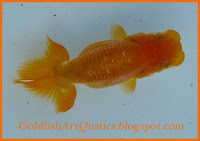The Art & Science of Top View Ranchu ~ 蘭壽的藝術科學
Engineers create that which has never been.
~Albert Einstein
 The features of the TVR tosais are getting more or less stabilized as they approach 100 days old. After almost 5 months, I could only keep less than 20 fishes this year for show and breeders. Considering the number of spawns that I attempted, I think this yield rate is not very encouraging. Besides my skills problem, it is also partly due to the high casualties and the bad egg qualities.
The features of the TVR tosais are getting more or less stabilized as they approach 100 days old. After almost 5 months, I could only keep less than 20 fishes this year for show and breeders. Considering the number of spawns that I attempted, I think this yield rate is not very encouraging. Besides my skills problem, it is also partly due to the high casualties and the bad egg qualities.
 For an art that emphasized so much on dynamic beauty - specifically, the grace and balance with which a TVR swims, the structure of a TVR is of utmost importance. The Ranchu, being a short tail fish without the dorsal fin, is likened to a boat without sail and having short oars. Hence, it is important to have a strong peduncle to propel the fish's movement and a good tail structure to maneuver the fish with ease.
For an art that emphasized so much on dynamic beauty - specifically, the grace and balance with which a TVR swims, the structure of a TVR is of utmost importance. The Ranchu, being a short tail fish without the dorsal fin, is likened to a boat without sail and having short oars. Hence, it is important to have a strong peduncle to propel the fish's movement and a good tail structure to maneuver the fish with ease.Keeping balance is a great challenge for the Ranchu. The shape of its side view profile also contributes to its overall balance as it "cuts" through the water like an aerodynamic profile in a wind tunnel.
 I have also observed that the orientation of the anal fins would affect the Ranchu's balance. Imagine a boat with a rudder bent to one side, it will not move straight given a straight forward push. Maybe that is the reason why the Japanese use the term "rudder" fins for the anal fins. In contrast, a goldfish with longer fin features is analogous to a boat with sail and bigger oars, any problem with balance would be easier to be mitigated with its bigger and more powerful fins.
I have also observed that the orientation of the anal fins would affect the Ranchu's balance. Imagine a boat with a rudder bent to one side, it will not move straight given a straight forward push. Maybe that is the reason why the Japanese use the term "rudder" fins for the anal fins. In contrast, a goldfish with longer fin features is analogous to a boat with sail and bigger oars, any problem with balance would be easier to be mitigated with its bigger and more powerful fins. Unlike a boat, the challenge posed to the Ranchu hobbyist is that a Ranchu is forever changing! As a Ranchu grows, it is constantly changing its width, length, weight and side view profile which all affects the swimming aesthetics and balance. The Ranchu breeder's quest to create a good bloodline of Ranchu with good structure for a beautiful swimmer is very much like the engineer's research on the type of structure, design and material to create a good boat, However, the development of a Ranchu does not stop there - the Ranchu hobbyist has to continuously balance the features of the Ranchu by carefully influencing the Ranchu's growth rate and its environment.
Unlike a boat, the challenge posed to the Ranchu hobbyist is that a Ranchu is forever changing! As a Ranchu grows, it is constantly changing its width, length, weight and side view profile which all affects the swimming aesthetics and balance. The Ranchu breeder's quest to create a good bloodline of Ranchu with good structure for a beautiful swimmer is very much like the engineer's research on the type of structure, design and material to create a good boat, However, the development of a Ranchu does not stop there - the Ranchu hobbyist has to continuously balance the features of the Ranchu by carefully influencing the Ranchu's growth rate and its environment.To add another level of challenge to the TVR hobby, the Japanese standard of a rectangular shaped dragon-head funtan and wide open tail are all against the design principles of an efficient swimmer! How can one design a beautiful boat with an almost flat bow and wide stern that glides effortlessly with balance? It is no wonder that the Japanese says that "A Ranchu is made". The making of a good TVR is indeed, both an art and an engineering feat!
Pictures:
Some self bred Tosai 2009.


















